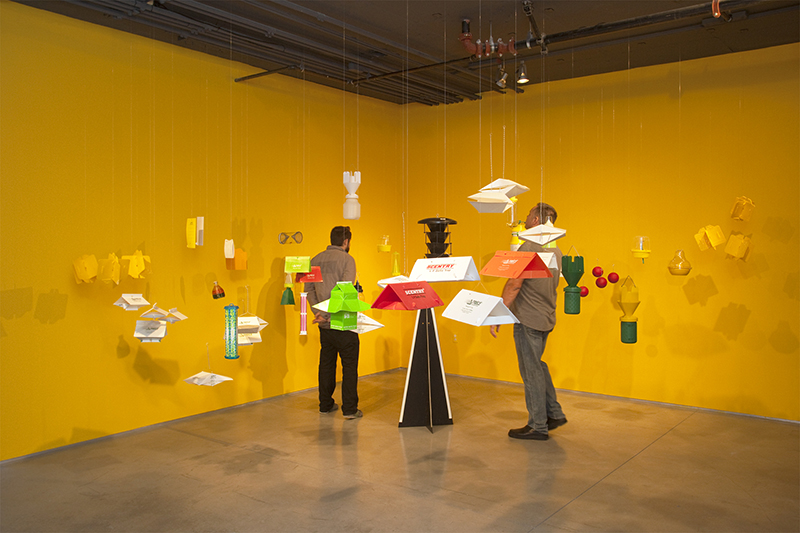All images by the ICZ
About the exhibition
ROBERT ZHAO RENHUI: FLIES PREFER YELLOW
Kadist Art Foundation, San Francisco
WEDNESDAY, 19 NOVEMBER, 2014 – SATURDAY, 10 JANUARY, 2015
Resulting from his three-month residency at Kadist Art Foundation, Flies Prefer Yellow is the North American debut exhibition of Singapore-based artist, Robert Zhao Renhui (b. 1983). Featuring installation and photographic works, the exhibition explores boundaries, systems, neuroses, and control through the artist’s encounters with one of the most inconspicuous insect species on earth–flies. Despite their ubiquity and adaptability (more than 145,000 species exist), flies remain nearly invisible to many humans. This dismissive outlook is attributed less to visual perception, and more to a psychological predisposition towards the insect’s lack of purpose—a manufactured negligence that determines what we see and what we do not. Rendering the unseen visible, and the ignored critical, this multidisciplinary exhibition amplifies the intersections of insect and human, natural and urbanized environments, and entomology and art practice.
During his residency, Zhao made multiple visits to the Sacramento insect lab of Dr. Martin Hauser, Senior Insect Biosystematist at the California Department of Food and Agriculture (and longtime acquaintance of the artist’s). Inspired by Hauser’s scientific impulse towards exhaustive taxonomy, Zhao began observing and cataloguing insects. Ranging from beetle-tracking within the urban core of San Francisco, to collecting the various insect carcasses from his windshield during road trips, the artist began accumulating observations about the indigenous insects, and in particular, the flies he encountered. In addition to the flies themselves, Zhao’s curiosity extends to the various traps and methods humans use to rid themselves of the pests. The exhibition’s title, Flies Prefer Yellow, on the one hand refers to the artist’s affectionate imagination through its anthropopathic tone, implying a desire to be friendly with the insects. On the other hand, the preference is actually a statistical observation as most commercial flytraps are produced in the color yellow. Through the lens of flies, the exhibition invites critical reflection on human’s paradoxical relationships with animals and our organic world.
Through this collision with art, the insect world, long suppressed and diminished by the congestion and monumentality of urban life, is revealed in the full glory of its contradictions: the fly is both friend and foe, beautiful and repellant, known, yet never fully described. Through languages of humor, repetition, contradiction and juxtaposition, Zhao’s practice negotiates the process of image making and the proximity of vision that continue to blur lines between objective documentation and fictional narrative.
On the evening of the opening reception, November 19 6-9pm, Dr. Martin Hauser joined Zhao and Xiaoyu Weng in conversation within a pop-up laboratory of his scientific materials and specimens. Monica Martinez, of Don Bugito, served edible insect appetizers alongside a special insect cocktail by Helena Keeffe.
http://www.kadist.org/en/programs/all/2083





Bagworm, Graperoot Borer, Gypsy Moth, Japanese Beetle, Pepper Weevil, Apple Maggot, Blueberry Maggot, Walnut Husk Fly, Cherry Fruit Fly, Whitefly, Thrip, Flying Aphid, Fungus Gnat, Mushroom Fly, Corn Rootworm, Rose Chafer, San Jose Scale, Squash Vine Borer, Winter Moth, Sweet Potato Weevil, Stink Bug, Elm Bark Beetle, Fruit Fly, Mediterranean Fruit Fly, Medfly, Olive Fruit Fly, Carrot Rust Fly, White Pine Weevil, Pecan Weevil, Plum Curculio, Citrus Weevil, Black Cherry Fruit Fly, Apple Blotch Leafminer, Spruce Budworm, Whitemarked Tussock Moth, European Pine Shoot Moth, Black Cutworm, Armyworm, Beet Army Worm, Cabbage Looper, Nantucket Pinetip Moth, Southwestern Corn Borer, Bumblebees, Tarnished Plant Bug, Eastern Apple Sawfly, Mites, Pink Bollworm, Codling Moth, Redbanded Leafroller, Pecan Nut Casebearer, Blackheaded Fireworm, Bagworm, Oriental Beetle, Indian Meal Moth, Tobacco Budworm, Arthur's Sunflower Moth, Honey BeeLeek Moth, Lima Bean Pod Borer, Old World Boll Worm, Potato Moth, Tomato Pinworm, Vine Mealybug, Soy Bean Looper
Installation of Insect Traps, Dimensions Variable





 Villa Dei Fiori, September to November.
Villa Dei Fiori, September to November.
Found Insects, Ethyl Alcohol, 144 Glass Vials, 60mm x 40mm (Diameter) each
All the insects found in the artist's residency apartment during his residency in California.


 San Francisco - Crescent City - Klamath - Eureka - Myers Flat - Garberville - Leggett - Ukiah - San Francisco
San Francisco - Crescent City - Klamath - Eureka - Myers Flat - Garberville - Leggett - Ukiah - San Francisco
Found Insects, Ethyl Alcohol, 101 Glass Vials, 15mm x 3 mm (Diameter) each
All the Insects that collided with the artist's car and subsequently collected from the front of a car from a 500 miles road trip for 7 days around California.

 He counts the stars and call them all by name
He counts the stars and call them all by name
2.1m x 1.5m
Chromogenic Color Print, face mounted on Plexiglass, Framed
A family portrait photograph of 4784 flies from a single family of flies. Each fly is meticulously labelled with information of its provenance and some of these flies mimics/pretends to be other insects like bees and wasps to cheat predators.


Borders
Installation of 99 Chromogenic Color Print, face mounted on Plexiglass, 45mm x 35mm each
Photographs of insects intercepted from trucks and vehicles at the Californian border by the California Department of Food and Agriculture. Insects, their eggs and larvas, sometimes as small as 1mm are sniffed out by specialized dogs looking for insects that might cause potential harm to the agriculture and ecosystem of the state. Specialists at the Plant Pest Diagnostics Branch will determine if the insects are potentially harmful from the photographs and decide if the vehicle can enter the country
 Pop-up Insect Laboratory on the night of the opening.
Pop-up Insect Laboratory on the night of the opening.
Copyright 2014, Institute of Critical Zoologists